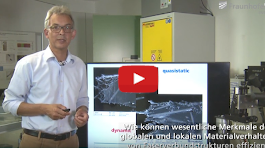Composite Materials
We investigate the relationships between the structure and properties of composite materials with polymer, ceramic and metal matrices, in order to assess their operational behavior. Our testing concepts account for microstructure and real loads. Properties of specimens are transferred to components through a combination of experimental and numerical methods. Newly developed material models enable us to predict the operational and failure behavior of composites and components and subsequently save time and money during material and component development.
- Mechanical evaluation of composites with polymer, ceramic and metal matrix, GFRP, CFRP, CMC, MMC as well as foamed and cellular materials
- Development of specific experiments
- Numerical modeling to determine microstructure-property relationships for prediction and optimization of material behavior
- Development and implementation of matched material models for composites, taking into account all relevant environmental and loading scenarios for use within common FEM systems
- Probabilistic material and component simulation
- Simulation of failure and application behavior of composite components
Contact us! Together we'll find a customized solution for the challenges you face.
 Fraunhofer Institute for Mechanics of Materials IWM
Fraunhofer Institute for Mechanics of Materials IWM
